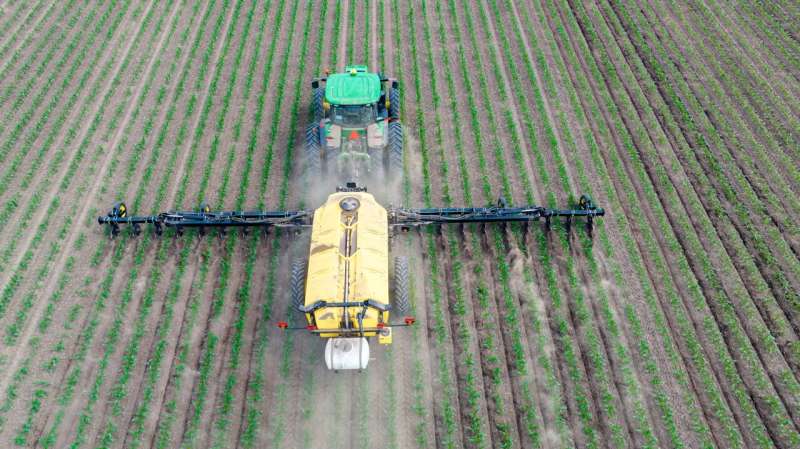
Hundreds of thousands of residents in Iowa have faced unprecedented restrictions on outdoor water usage due to dangerously high levels of nitrate in drinking water. For nearly a month, local authorities have mandated that citizens refrain from watering lawns, washing cars, and filling pools, even in the absence of drought conditions. Cities around Des Moines have even shut down splash pads amid the summer heat, highlighting the severity of the situation.
The issue stems from excessive nitrate runoff, a byproduct of commercial fertilizers and livestock waste. Persistent rainfall has exacerbated the problem by washing nutrients from agricultural fields into rivers and streams. According to Tami Madsen, executive director of Central Iowa Water Works, this is the first instance of a lawn watering ban in the state, marking a critical moment in Iowa’s ongoing struggle with water quality.
Federal regulations limit nitrate levels in drinking water due to health risks associated with its consumption, particularly in infants. The condition known as blue baby syndrome is linked to elevated nitrate levels. Furthermore, research has increasingly suggested connections between nitrate consumption and cancer, raising alarms among residents.
Growing Regional Concerns
While Iowa’s nitrate levels are particularly acute, similar issues are emerging in other regions, from California to the Chesapeake Bay. Experts warn that climate change will likely worsen the situation, with increasing cycles of drought and severe storms contributing to agricultural runoff. Rebecca Logsdon Muenich, an associate professor at the University of Arkansas, noted that nitrogen travels with water, complicating efforts to manage nitrate levels during severe weather events.
In Iowa, the problem has been compounded by the extensive use of nitrogen-rich fertilizers in agriculture and the state’s unique underground drainage systems, which funnel excess nutrients into water bodies. The water treatment facilities serving the Des Moines metropolitan area have invested heavily in nitrate filtration technology, with one of the largest systems operating at a cost of approximately $16,000 per day.
Calls for Action and Accountability
As residents cope with these restrictions, a report commissioned by Polk County revealed that the Raccoon and Des Moines rivers, primary sources of drinking water, have some of the highest nitrate levels in the United States. Larry Weber, a professor of civil and environmental engineering at the University of Iowa, emphasized that while individual farmers aim to meet market demands, systemic changes are needed to mitigate pollution.
He pointed to the fact that Iowa’s waterways export hundreds of millions of pounds of nitrogen annually, much of which ends up in the Gulf of Mexico. Weber expressed concern that water restrictions may become increasingly common as more cities grapple with high nitrate levels.
The Iowa state government has faced criticism for cutting funding for water quality monitoring, leaving the Iowa Nutrient Research Center to potentially shut down vital sensors next year. In response, Mike Naig, Iowa’s Agriculture Secretary, stated that many local groups are already working on conservation efforts to improve water quality.
Naig also announced a new $1.9 million water quality project that aims to install landscape buffers and bioreactors upstream of Des Moines to reduce nutrient runoff. This funding includes $244,000 from the state, highlighting a growing recognition of the need for effective solutions.
Community Engagement and Citizen Action
The recent water restrictions have sparked significant interest from community members in the Izaak Walton League of America‘s Nitrate Watch program, which equips volunteers with kits to test nitrate levels in local waterways. Heather Wilson, the league’s Midwest Save Our Streams coordinator, reported receiving over 300 inquiries from Iowans in just one week, indicating a heightened awareness of water quality issues.
Retired science teacher Birgitta Meade has been actively testing nitrate levels in her rural Iowa home and noted that they are higher than ever. While her levels are below federal standards, she worries about the potential health risks associated with low-level nitrate consumption. Meade has voiced frustration at the agricultural practices contributing to pollution, stating, “These are people who are choosing to poison their neighbors.”
The situation in small towns like Pratt, Kansas mirrors Iowa’s challenges. Some wells in Pratt have recorded nitrate levels above federal standards, prompting the city to consider a new water treatment facility estimated to cost over $45 million. City Manager Regina Goff expressed frustration over the financial burden of meeting safety standards, describing it as an “unfunded mandate.”
As Iowa grapples with these urgent water quality issues, the combination of community engagement, expert analysis, and government action will be crucial in addressing the challenges posed by nitrate pollution and ensuring safe drinking water for all residents.






